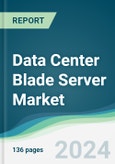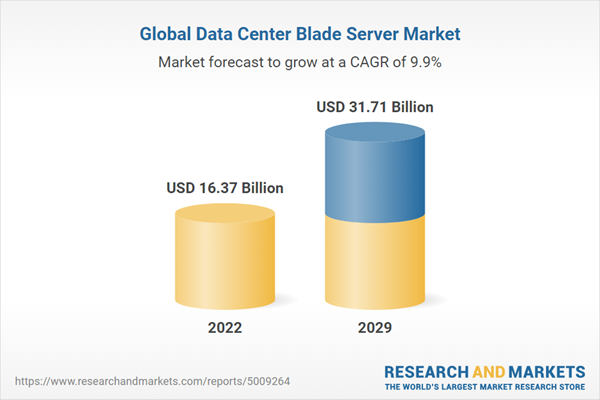The global data center blade server market is projected to grow at a CAGR of 9.9% during the forecast period, reaching a total market size of US$31.707 billion in 2029 from US$16.371 billion in 2022.
The demand for data centre blade servers is increasing due to the growing focus on low power consumption and high productivity in the existing infrastructure.The data centre blade server market growth is driving because of less usage of physical space and energy, providing more processing power in less space which further deducts the primary expenses for the enterprise. The installation of the data centre blade server even reduces secondary costs like hardware cabling costs, facility charges, and the personnel hours required to configure and manage systems. The rise in demand for data centre blade servers is also attributed to the fact that they are a great substitute for traditional racks and tower servers that occupy a large surface area and consume a huge amount of power.
The increasing computer density, business optimization needs, and virtualization are also the reasons for the growing demand for data centre blade servers. Companies are increasingly demanding data centre blade servers to streamline their IT operations and speed up their delivery of services. The increasing adoption of virtualization applications, increasing load on data centres, and effective utilization of data centre space are also key drivers for the data centre blade server market.
The data centre blade server is segmented by function, end-user, and geography. Based on function, the data centre blade server market is segmented into web hosting, virtualization, and cluster computing. The market is also segmented based on users as colocation service providers, cloud service providers, and enterprises.
Cluster Computing and Web Hosting hold a notable share
The cluster computing and web hosting segments hold a notable share in the data centre blade server market. The increasing requirement for storage space and connectivity around the world with its branches, clients, and vendors through the network will provide businesses with better accessibility and wider reach to their customers. The virtualization segment will witness a substantial CAGR during the forecast period owing to rising investments in artificial intelligence (AI) and its applications like augmented reality (AR). Virtualization is providing more space for enterprises and colocation centres, making more space for cloud computing and providing a bigger platform to share with their clients. The increase in usage of web hosting, virtualization, and cluster computing is due to a reduction in cost, efficient delivery service, wider reach, flexibility, scalability, and management of multiple infrastructures at once.Colocation Service providers to witness considerable market growth
The Colocation Service Provider segment is projected to grow at a sizable compound annual growth rate during the forecast period. Growing adoption of colocation solutions and services owing to the rising volume of big data is leading to a rise in the demand for colocation which, along with a growing focus on low power consumption, is boosting the adoption of data centres blade servers for reducing overall cost, while increasing their virtual space for providing their clients with more storage space and better networking solutions. The enterprise segment will also grow during the forecast period owing to the increasing demand for storage space, networking, and security, which is making enterprises move towards using data centre blade servers for higher efficiency and cost-effectiveness.North America is expected to hold a significant share during the forecast period
The region is witnessing a transition from storage on individual devices and systems to core clouds and network edges. A recent survey conducted by Intel Security indicates that the number of businesses utilizing hybrid cloud services alone has increased by three times. It can be very advantageous that cloud providers are boosting security and enabling stronger, more reliable systems in businesses. Furthermore, the region's businesses are heavily investing in AI infrastructure, necessitating the immediate processing of the massive volumes of data being gathered in real-time.Product Offerings
- The Supermicro SuperBlade: For the most demanding applications that demand high CPU density and the quickest networking currently available, Supermicro SuperBlade is designed. The new generation blade portfolio from Supermicro is made to reduce the total cost of ownership (TCO) of important data centre components like cooling, power usage, node density, and networking administration. Additionally, the Supermicro SuperBlade powered by AMD EPYC processors of the third generation is a reliable platform that satisfies the needs of enterprise customers for on-premises private/hybrid cloud installations.
- HPE ProLiant e910: The HPE ProLiant e910 Server Blade supports industry-standard technology and makes use of the Intel Xeon Scalable processor series. With HPE iLO 5, which incorporates server administration features and Silicon Root of Trust from HPE, the HPE ProLiant e910 Server Blade allows you to securely set up, monitor, and upgrade HPE servers from anywhere. The HPE ProLiant e910 Server Blades offer a wide variety of GPU accelerator configurations, enhancing the potential for deep learning at the edge.
Market key launches
- In January 2023, the opening of two new Canadian data centers in Toronto and Montreal by ManageEngine, the enterprise IT management branch of Zoho Corporation, will provide better data security and privacy to clients in the area. Large Canadian corporations, including those in the banking, financial services, and government sectors, are emphasizing the need for localized data processing and storage due to stricter privacy laws and performance standards.
- In January 2023, Cisco announced the availability of the 7th generation of UCS C-Series and X-Series servers, which are powered by 4th generation Intel Xeon Scalable processors. Cisco has introduced the Cisco UCS X210c M7 Compute Node and the Cisco UCS X410c M7 Compute Node, two new blades for the X-Series that support the newest Intel processors.
Segmentation:
By Function
- Web Hosting
- Virtualization
- Cluster Computing
By End-User
- Colocation Providers
- Cloud Providers
- Enterprises
By Geography
- North America
- USA
- Canada
- Mexico
- South America
- Brazil
- Argentina
- Others
- Europe
- Germany
- France
- United Kingdom
- Spain
- Others
- Middle East and Africa
- Saudi Arabia
- Israel
- Others
- Asia Pacific
- China
- Japan
- South Korea
- India
- Taiwan
- Thailand
- Indonesia
- Others
Table of Contents
1. INTRODUCTION
2. RESEARCH METHODOLOGY
3. EXECUTIVE SUMMARY
4. MARKET DYNAMICS
5. DATA CENTRE BLADE SERVER MARKET, BY FUNCTION
6. DATA CENTRE BLADE SERVER MARKET, BY END-USER
7. DATA CENTRE BLADE SERVER MARKET, BY GEOGRAPHY
8. COMPETITIVE ENVIRONMENT AND ANALYSIS
9. COMPANY PROFILES
Samples

LOADING...
Companies Mentioned
- Super Micro Computer, Inc.
- Dell Inc.
- Intel Corporation
- Oracle Corporation
- Cisco Systems, Inc.
- Hitachi Vantara LLC
- IBM
- Lenovo
- AVADirect Custom Computers
- Hewlett Packard Enterprise Development LP
Methodology

LOADING...
Table Information
| Report Attribute | Details |
|---|---|
| No. of Pages | 136 |
| Published | February 2024 |
| Forecast Period | 2022 - 2029 |
| Estimated Market Value ( USD | $ 16.37 Billion |
| Forecasted Market Value ( USD | $ 31.71 Billion |
| Compound Annual Growth Rate | 9.9% |
| Regions Covered | Global |
| No. of Companies Mentioned | 10 |









